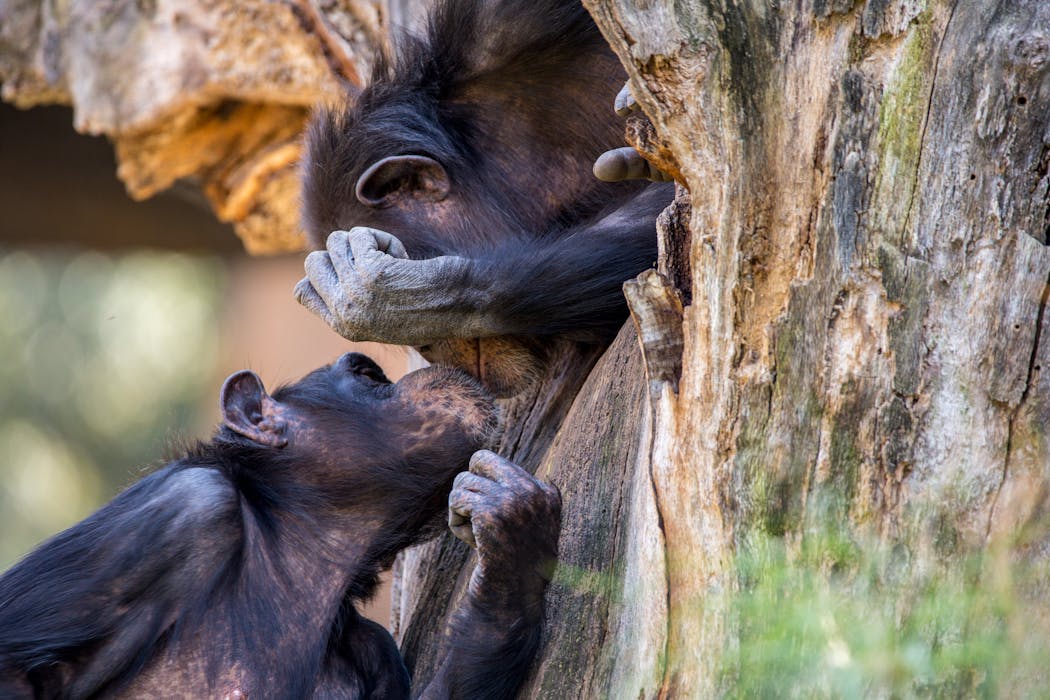
If I asked you to imagine your dream snog, chances are it wouldn’t be with a Neanderthal; burly and hirsute as they may be. However, my team’s new research suggests that these squat beefcakes might have been right up your ancestors’ street.
In our new paper, colleagues and I investigated kissing in monkeys and apes, including modern humans and Neanderthals, to reconstruct its evolutionary history for the first time.
Before we could do this, we needed to construct a definition of kissing that was applicable across a wide variety of animals. This sounds simple, but lots of behaviour looks like kissing at first glance.
Many primates pre-chew food for their offspring and feed this to them orally (a behaviour known as premastication). Ants also exchange fluid and food mouth-to-mouth in a process known as trophallaxis. Sometimes they do this mouth-to-anus too, but that is harder to mistake for a kiss. Tropical French grunt fish can also be seen passionately locking lips. However, this behaviour is no French kiss. It is part of a dominance display known as “kiss-fighting”.
We excluded kissing-like behaviour from our definition. We also excluded interactions that might be accidental or occur between members of different species, such as when dogs lick their owners’ mouths (or the time a capuchin monkey tried to snog me, but that’s a different story).
Taking all this into account, we define kissing as non-aggressive, directed, mouth-to-mouth contact between members of the same species, that doesn’t involve food transfer. By this definition, all sorts of animals kiss, from polar bears enjoying spirited rounds of tonsil-tennis, to prairie dogs softly canoodling.
We used this definition to trawl published scientific papers, searching for observations of kissing in the group of monkeys and apes that evolved in Africa, Asia and Europe. It turns out that a handful of monkeys, and most apes, have been observed to kiss, with the exception of Eastern gorillas and the small apes (gibbons and siamangs).
The type of kiss can vary, both within and between species. Kissing between bonobos tends to be an exclusively sensual affair with “prolonged tongue-tongue interaction”. Other apes have a spicy side too, sometimes kissing as foreplay, or during sex.
Kissing also occurs in affectionate, platonic contexts across most apes, such as when mothers kiss their infants, or during greetings and reconciliation.
We combined this data with information on the evolutionary relationships between different species, in what is known as a phylogenetic comparative analysis. This technique allowed us to model the evolutionary history of kissing, and explore whether it was likely to have been present in the ancestors of different groups of species.
Our results paint early apes in an amorous light, showing that the ancestors of large apes were kissing each other as far back as 21.5 – 16.9 million years ago. Clearly, they were onto a good thing because they’ve been at it ever since, apart from Eastern gorillas, who just don’t seem to be into it.
Our reconstructions also shed light on the proclivities of Neanderthals who, it turns out, were also likely to be partial to a good smooch. Previous research shows that modern humans and Neanderthals shared an oral microbe long after the two species diverged into separate lineages. For this to happen, the microbes had to have been transferred between the two species. In other words, they were swapping saliva.
There could, of course, be an innocent explanation for this. Perhaps the two species were simply sharing food with one another over a friendly campfire. On the other hand, when you consider that most people of non-African descent have some Neanderthal ancestry, alongside our finding that kissing was present in Neanderthals, a saucier picture emerges.
So, did humans and Neanderthals get off with each other? Unfortunately, kissing doesn’t preserve in the fossil record, so we’ll never be able to say for sure, but the evidence certainly points in that direction. One thing I can say for certain is that I’ll never look at a Neanderthal the same way again.
This article is republished from The Conversation, a nonprofit, independent news organization bringing you facts and trustworthy analysis to help you make sense of our complex world. It was written by: Matilda Brindle, University of Oxford
Read more:
- Bonobo mothers meddle in their sons’ sex lives – making them three times more likely to father children
- Children’s books feature tidy nuclear families – but the animal kingdom tells a different story
- Our ape cousins show us empathy has deep evolutionary roots – new research
Matilda Brindle has previously received funding from the Natural Environment Research Council and the Leakey Foundation


 The Conversation
The Conversation
 Deseret News
Deseret News NewsChannel 5 Nashville
NewsChannel 5 Nashville Atlanta Black Star Entertainment
Atlanta Black Star Entertainment AlterNet
AlterNet